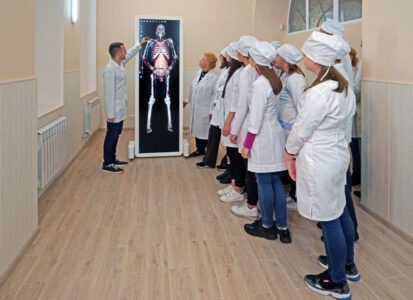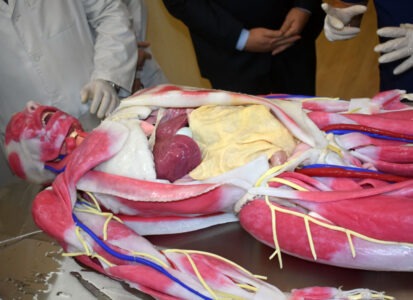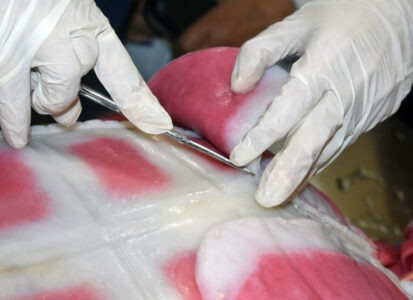In order to modernise the teaching of disciplines, increase interest among students and improve the acquisition of practical skills, the Educational and Research Centre “Practical Morphology” was opened in 2019 at the Department of Human Anatomy of KhNMU. It consists of three laboratories, which, in turn, correspond to the three main areas of studying human structure in the modern educational space:
- Laboratory of Simulation Technologies;
- Laboratory of Artificial Organs and Systems;
- Laboratory for working with cadaveric material.
Laboratory of Simulation Technologies. This laboratory presents Anatomage table, which is the most technologically advanced anatomical visualisation system in medical education, adopted by many of the world’s leading medical schools and universities. Technically, Anatomage table is a very powerful computer with two touch panels, it is very easy to use and provides an opportunity to demonstrate to a group of students all the most complex and difficult to access features of the human body structure. Due to the fact that we purchased the latest model, namely Anatomage table 6.0 convertible, we can work in two modes: horizontal and vertical. In the software, we have four full-fledged bodies and a fifth one collected through CT scans (which is the largest database among existing anatomical tables, which has no analogues), a database of ultra-high definition anatomical structures, a library of pathological conditions, a collection of histological specimens, a catalogue of three-dimensional photographs of anatomical organs and parts of the human body, embryological images, even a collection of three-dimensional animal anatomy, and much more.
The Department of Human Anatomy, Clinical Anatomy and Operative Surgery of KhNMU has the first full-fledged Virtual Reality Classroom in Ukraine. The classroom is equipped with virtual reality helmets (10 pcs.) for students and one professional helmet for a teacher, a computer centre with an interactive panel and a licensed package of 3D Organon VR Anatomy software.
The limitless possibilities of this platform allow for a more in-depth and comprehensive study of anatomical structures in virtual reality. It allows students to immerse themselves in a virtual world with the ability to zoom in, out, rotate, and move around anatomical structures together with a teacher. It also contains descriptions of anatomical models with an extensive database of official anatomical terminology. Thanks to 3D Organon VR Anatomy, we are taking a step into the state-of-the-art world of technology, which significantly expands the possibilities of the educational process of studying human anatomy.
Laboratory of Artificial Organs and Systems. This part of the centre is equipped with a Syndaver synthetic cadaver. This is a unique dummy that is the first not only in Ukraine but also in Eastern Europe. It was developed by Syndaver labs, which is located in Tampa, Florida. Since 2004, the company’s founder, Christopher Sakizlis, has been working on developing a range of more than 100 types of artificial tissues made from salt water and synthetic fibres that can mimic human and other living tissues for medical purposes. When enough individual organs had been produced, Sakizlis assembled his first artificial body in 2009. Each structure or organ mimics the physical and biomechanical properties of living human analogues to a near-perfect degree. It allows you to clearly demonstrate the location and appearance of the organ, explain possible movements in the joints, etc. Each Syndaver is assembled exclusively by hand, step by step, starting with the skeleton, muscles, internal organs, and vascular and nervous components, after which a complete “body” is formed that can be used for educational purposes. Syndaver is completely safe because it is stored in plain water with a small amount of chlorine, much like swimming pools.
Laboratory for working with cadaveric material. This type of activity is intended for conducting training sessions and scientific research using preparations from the collection of the Department and processing and updating preparations of the Department’s museum.



